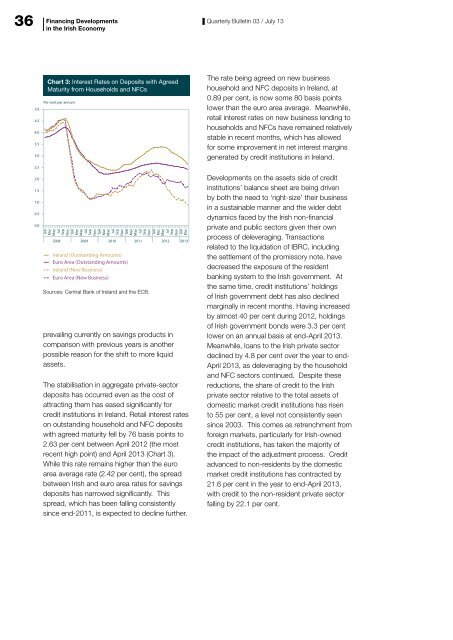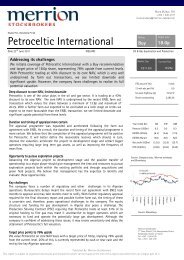Quarterly Bulletin Q3 2013
Quarterly Bulletin Q3 2013
Quarterly Bulletin Q3 2013
Create successful ePaper yourself
Turn your PDF publications into a flip-book with our unique Google optimized e-Paper software.
36<br />
Financing Developments<br />
<strong>Quarterly</strong> <strong>Bulletin</strong> 03 / July 13<br />
in the Irish Economy<br />
5.0<br />
4.5<br />
4.0<br />
3.5<br />
3.0<br />
2.5<br />
2.0<br />
1.5<br />
1.0<br />
0.5<br />
0.0<br />
Chart 3: Interest Rates on Deposits with Agreed<br />
Maturity from Households and NFCs<br />
Per cent per annum<br />
Jan<br />
Mar<br />
May<br />
Jul<br />
Sep<br />
Nov<br />
Jan<br />
Mar<br />
May<br />
Jul<br />
Sep<br />
Nov<br />
Jan<br />
Mar<br />
May<br />
Jul<br />
Sep<br />
Nov<br />
Jan<br />
Mar<br />
May<br />
Jul<br />
Sep<br />
Nov<br />
Jan<br />
Mar<br />
May<br />
Jul<br />
Sep<br />
Nov<br />
prevailing currently on savings products in<br />
comparison with previous years is another<br />
possible reason for the shift to more liquid<br />
assets.<br />
Jan<br />
Mar<br />
2008 2009 2010 2011 2012 <strong>2013</strong><br />
Ireland (Outstanding Amounts)<br />
Euro Area (Outstanding Amounts)<br />
Ireland (New Business)<br />
Euro Area (New Business)<br />
Sources: Central Bank of Ireland and the ECB.<br />
The stabilisation in aggregate private-sector<br />
deposits has occurred even as the cost of<br />
attracting them has eased significantly for<br />
credit institutions in Ireland. Retail interest rates<br />
on outstanding household and NFC deposits<br />
with agreed maturity fell by 76 basis points to<br />
2.63 per cent between April 2012 (the most<br />
recent high point) and April <strong>2013</strong> (Chart 3).<br />
While this rate remains higher than the euro<br />
area average rate (2.42 per cent), the spread<br />
between Irish and euro area rates for savings<br />
deposits has narrowed significantly. This<br />
spread, which has been falling consistently<br />
since end-2011, is expected to decline further.<br />
The rate being agreed on new business<br />
household and NFC deposits in Ireland, at<br />
0.89 per cent, is now some 80 basis points<br />
lower than the euro area average. Meanwhile,<br />
retail interest rates on new business lending to<br />
households and NFCs have remained relatively<br />
stable in recent months, which has allowed<br />
for some improvement in net interest margins<br />
generated by credit institutions in Ireland.<br />
Developments on the assets side of credit<br />
institutions’ balance sheet are being driven<br />
by both the need to ‘right-size’ their business<br />
in a sustainable manner and the wider debt<br />
dynamics faced by the Irish non-financial<br />
private and public sectors given their own<br />
process of deleveraging. Transactions<br />
related to the liquidation of IBRC, including<br />
the settlement of the promissory note, have<br />
decreased the exposure of the resident<br />
banking system to the Irish government. At<br />
the same time, credit institutions’ holdings<br />
of Irish government debt has also declined<br />
marginally in recent months. Having increased<br />
by almost 40 per cent during 2012, holdings<br />
of Irish government bonds were 3.3 per cent<br />
lower on an annual basis at end-April <strong>2013</strong>.<br />
Meanwhile, loans to the Irish private sector<br />
declined by 4.8 per cent over the year to end-<br />
April <strong>2013</strong>, as deleveraging by the household<br />
and NFC sectors continued. Despite these<br />
reductions, the share of credit to the Irish<br />
private sector relative to the total assets of<br />
domestic market credit institutions has risen<br />
to 55 per cent, a level not consistently seen<br />
since 2003. This comes as retrenchment from<br />
foreign markets, particularly for Irish-owned<br />
credit institutions, has taken the majority of<br />
the impact of the adjustment process. Credit<br />
advanced to non-residents by the domestic<br />
market credit institutions has contracted by<br />
21.6 per cent in the year to end-April <strong>2013</strong>,<br />
with credit to the non-resident private sector<br />
falling by 22.1 per cent.




